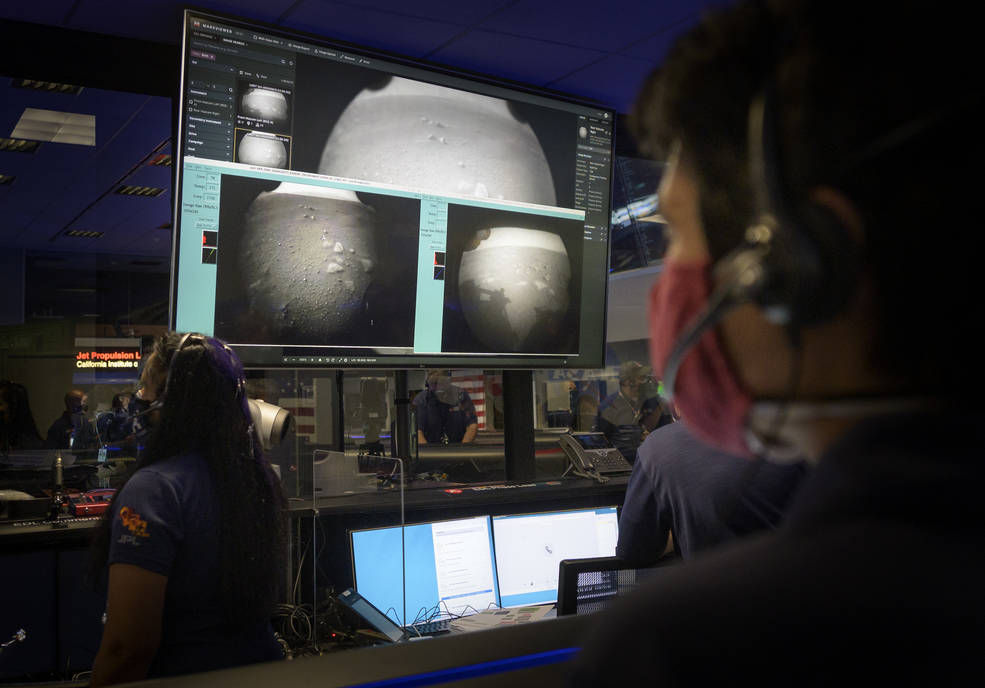
For SpaceUpClose.com & RocketSTEM
CAPE CANAVERAL, FL – After enduring the harrowing ‘7 Minutes of Terror’ plunge through the Martian atmosphere following a 7 month interplanetary journey NASA’s Perseverance rover nailed her nail-biting landing on Mars Thursday afternoon, Feb. 18, and transmitted the first two images just moments later from the floor of the Jezero Crater landing site to reveal an alien but scientifically bountiful terrain she will explore in search of ancient microbial life.
Perseverance is the most powerful and sophisticated robot ever dispatched from Earth to the most daring, difficult and scientifically rewarding landing site ever attempted by the agency on the surface of the Red Planet at Jezero crater – that simultaneously begins the first leg of a truly ground breaking astrobiology mission aimed at collecting pristine soil and regolith samples that will be returned to Earth a decade from now in search of tell-tale signs of past life.
Confirmation of the successful touchdown was announced in mission control at NASA’s Jet Propulsion Laboratory in Southern California at 3:55 p.m. EST (12:55 p.m. PST), during a live broadcast on NASA TV.
“Touchdown confirmed!” said the JPL commentator at the moment safe touchdown was confirmed.
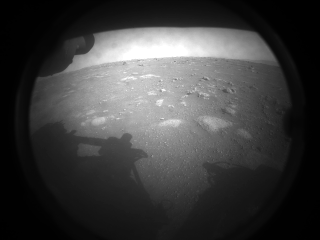
Credit: NASA/JPL-Caltech
Everything in the hugely complex entry, descent and landing (EDL) sequence worked perfectly.
“I’m safe on Mars. Perseverance will get you anywhere,” Perseverance tweeted post touchdown from Jezero Crater.
I’m safe on Mars. Perseverance will get you anywhere.
— NASA's Perseverance Mars Rover (@NASAPersevere) February 18, 2021
NASA’s 1 ton Perseverance rover along with the Ingenuity Mars Helicopter attached to its belly was barreling towards the Red Planet today when it smashed into the Martian atmosphere at 3:48 p.m. EST (12:48 p.m. PST) at 12,000 MPH (19,500 kph) to begin the harrowing ‘7 Minutes of Terror’ plunge on a do or die mission that had to slow down swiftly via friction, the heat shield, supersonic parachutes and retro rockets on the skycrane that then lowered the rover on tethers in the final seconds ultimately ending in a precision guided soft touchdown at Jezero at just 2 MPH.
The largest, most advanced rover NASA has sent to another world touched down on Mars after a 203-day journey traversing 293 million miles (472 million kilometers) of interplanetary space since launching in July 2020 after surviving the fiery descent through the thin Martian atmosphere and scorching heats up to some 2,370 degrees Fahrenheit (about 1,300 degrees Celsius) during the nail biting plunge.
Cheers erupted in mission control at NASA’s Jet Propulsion Laboratory as controllers confirmed that NASA’s Perseverance rover and the Ingenuity Mars Helicopter attached to her belly touched down safely on Mars exactly as planned.
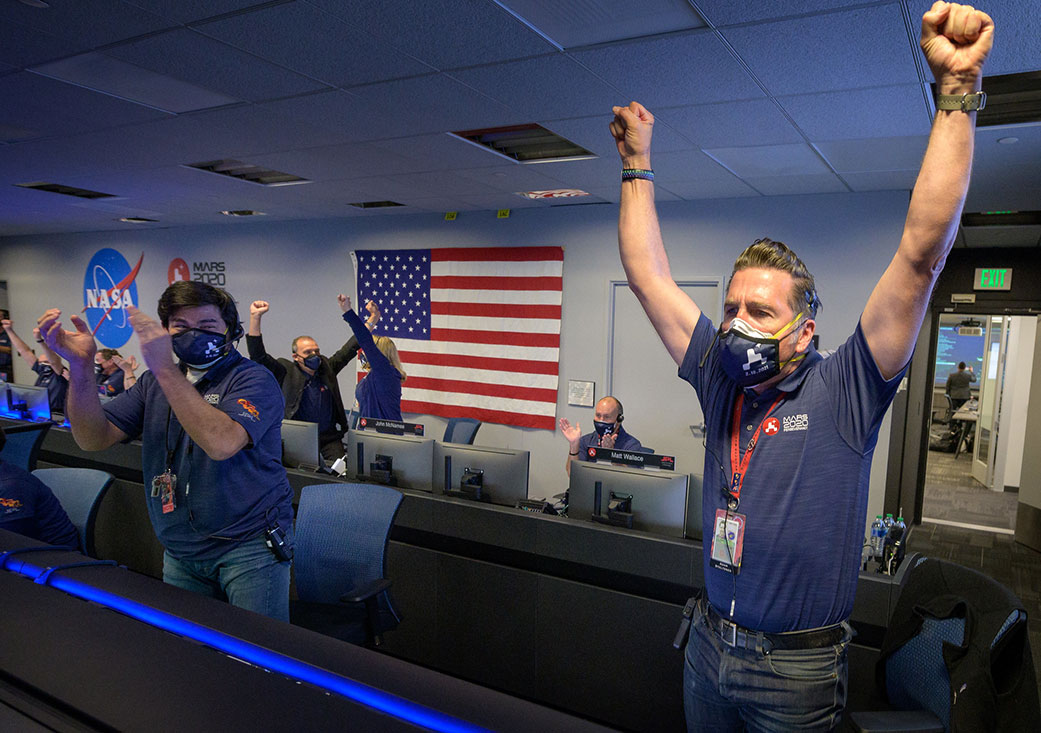
President Biden quickly congratulated the NASA and JPL teams post landing via tweet:
“Congratulations to NASA and everyone whose hard work made Perseverance’s historic landing possible. Today proved once again that with the power of science and American ingenuity, nothing is beyond the realm of possibility,” tweeted President Biden, along with a photo of him watching the landing live.
Congratulations to NASA and everyone whose hard work made Perseverance’s historic landing possible. Today proved once again that with the power of science and American ingenuity, nothing is beyond the realm of possibility. pic.twitter.com/NzSxW6nw4k
— President Biden (@POTUS) February 18, 2021
Biden also called acting NASA Administrator Steve Jurczyk while he was being interviewed by the media.
“His first words were ‘Congratulations, man,’ and I knew it was him,” Jurczyk said to media about the surprise call from President Biden.
“He talked about how proud he was of what we had accomplished.”
“He was as psyched as I am,” Jurczyk exclaimed.
“Hello, world. My first look at my forever home,” Perseverance tweeted her 1st image from Mars from the front hazcam
Hello, world. My first look at my forever home. #CountdownToMars pic.twitter.com/dkM9jE9I6X
— NASA's Perseverance Mars Rover (@NASAPersevere) February 18, 2021
“And another look behind me. Welcome to Jezero Crater,” Perseverance tweeted her 2nd image from Mars from the rear hazcam
And another look behind me. Welcome to Jezero Crater. #CountdownToMars pic.twitter.com/dbU3dhm6VZ
— NASA's Perseverance Mars Rover (@NASAPersevere) February 18, 2021
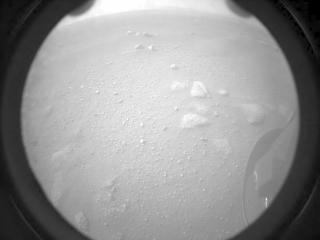
Perseverance is the agency’s ninth mission to land on the Red Planet and the fifth rover after Sojourner, Spirit, Opportunity and Curiosity.
Perseverance quickly transmitted back the first two raw images taken by rovers the front and rear hazcam cameras – with the lens caps still on in order to protect the cameras from dust thrown up by the eight landing thrusters on the descent stage during sky crane maneuver.
“Wow. Just an amazing, incredible day,” said acting NASA Administrator Steve Jurczyk at a post-landing briefing at JPL. “I could not be more proud of the team and what they’ve accomplished under challenging circumstances.”
“This landing is one of those pivotal moments for NASA, the United States, and space exploration globally – when we know we are on the cusp of discovery and sharpening our pencils, so to speak, to rewrite the textbooks.”
“The Mars 2020 Perseverance mission embodies our nation’s spirit of persevering even in the most challenging of situations, inspiring, and advancing science and exploration. The mission itself personifies the human ideal of persevering toward the future and will help us prepare for human exploration of the Red Planet.”
Perseverance counts as the 3rd of 3 spaceships from Earth and successfully concludes the arrival of the Martian Invasion Fleet following the successful orbital arrivals of the China Tainwen-1 probe and UAE Hope Orbiter last week on Feb 9 & 10.
“Because of today’s exciting events, the first pristine samples from carefully documented locations on another planet are another step closer to being returned to Earth,” said Thomas Zurbuchen, associate administrator for science at NASA.
“Perseverance is the first step in bringing back rock and regolith from Mars. We don’t know what these pristine samples from Mars will tell us. But what they could tell us is monumental – including that life might have once existed beyond Earth.”
Critical to Perseverance landing success was the development and inclusion of new hazard avoidance navigation technology called the Terrain-Relative Navigation (TRN) system that autonomously guided the spacecraft during final descent. TRN is an advance over Curiosity.
The Perseverance Mars 2020 mission will search for signs of past microbial life, characterize Mars’ climate and geology, collect samples for future return to Earth, and pave the way for human exploration of the Red Planet.
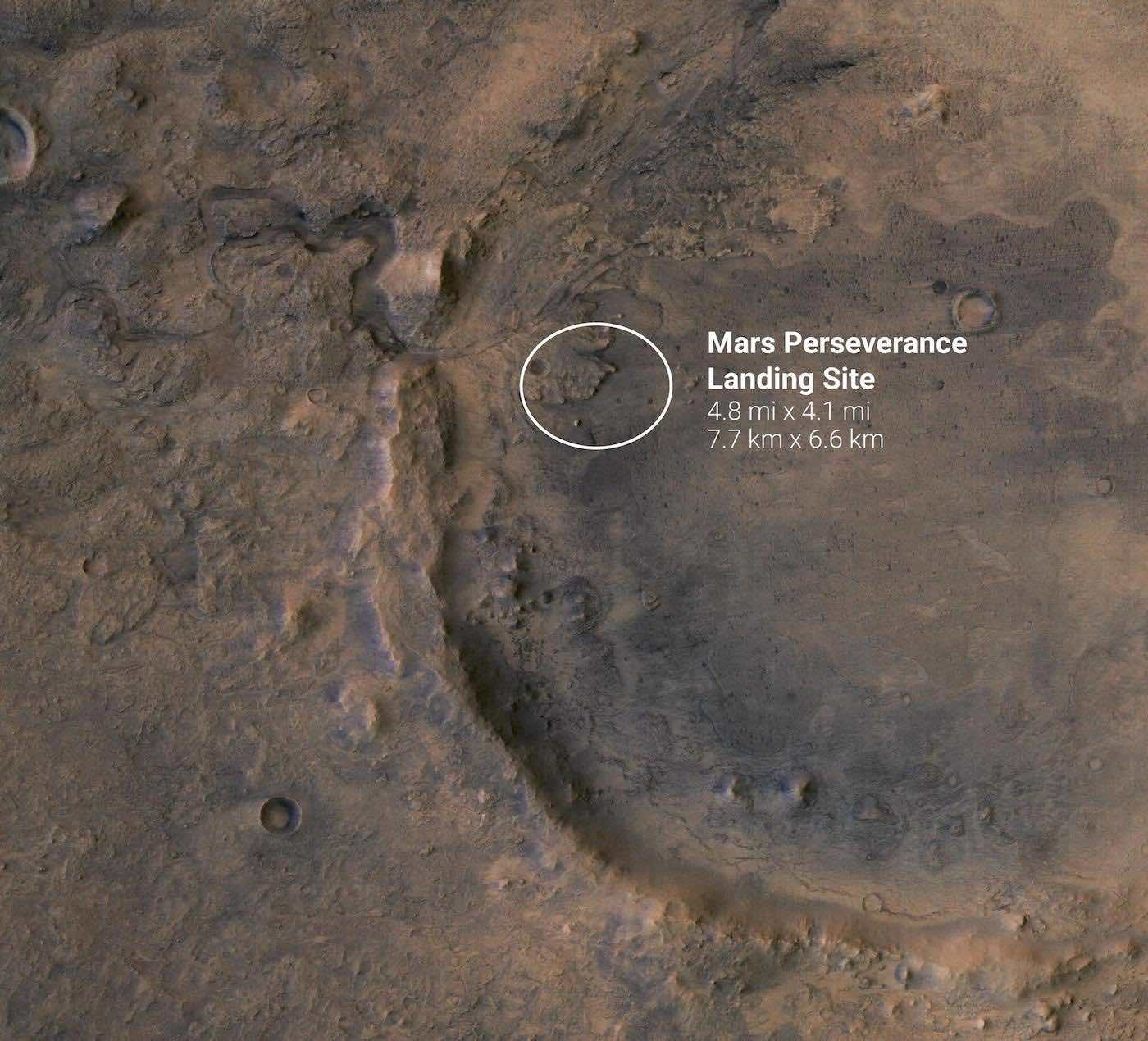
Also aboard is Ingenuity, a twin-rotor, solar-powered helicopter attached to the belly of the rover, will become the first aircraft to fly on another world.
The 1 ton rover will spend at least one Mars year (two Earth years) exploring the landing site region.
Following the safe landing Perseverance definitively starts the ‘Holy Grail’ goal of Mars Sample Return – sought after by scientists for decades to retrieve Red Planet soil samples and bring them back to Earth as soon as 2031 for the best possible analysis with the most sophisticated scientific instruments available to humankind – to help determine if life ever existed past or present on the Red Planet.
“Perseverance is our robotic astrobiologist, and it will be the first rover NASA has sent to Mars with the explicit goal of searching for signs of ancient life,” said Zurbuchen, at a media briefing Feb 16.
“It will build upon what we currently know from our previous rovers, orbiters and landers. And it will attempt to answer an age-old question that has eluded humanity for generations: whether life has ever existed elsewhere beyond our own planet, our Earth.”
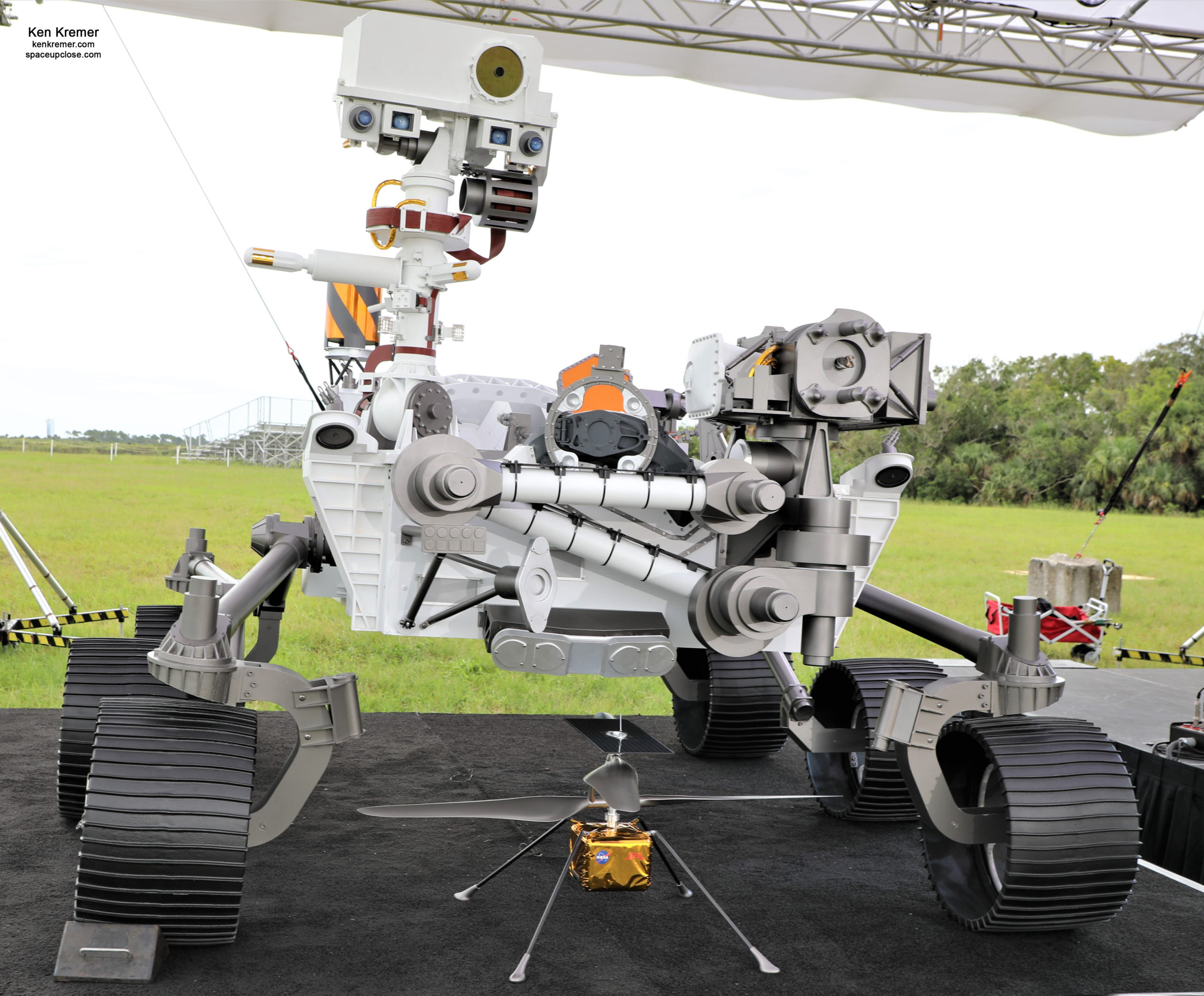
Perseverance is the first leg in a multi-mission astrobiology joint venture with ESA (European Space Agency) to return the first pristine Martian surface samples back to Earth as soon as 2031.
Perseverance truly begins the decade long effort called Mars Sample Return and equipped with a Sample Caching System to collect rock and regolith (broken rock and dust) by drilling into the surface at Jezero and storing them inside 43 pristine sample collection tubes that will help answer fundamental questions about the existence of life beyond Earth.”
Three future missions currently in the planning stages by NASA in collaboration with ESA (European Space Agency) will work together to bring the samples back to Earth, where they will undergo in-depth analysis by scientists around the world using equipment far too large and complex to send to the Red Planet.
Perseverance is a robotic scientist weighing about 2,260 pounds (1,025 kilograms) and includes a robotic arm with a 99-pound (45-kilogram) turret at the end.
The rover is equipped with six advanced aluminum wheels on a rocker-bogie system.
The SUV sized rover dimensions are 10 feet (3 m) long, 9 feet (2.7 m) wide and 7 feet (2.2 m) tall with a 7 feet (2.1 meters) long robotic arm.
The rover is equipped with seven different scientific instruments and the mission includes 25 cameras – the most ever to Mars and deep space. The rover itself is equipped with 19 cameras.
The science payload has a mass of 130 pounds (59 kilograms) for seven instruments: Mastcam-Z, Mars Environmental Dynamics Analyzer (MEDA), Mars Oxygen In-Situ Resource Utilization Experiment (MOXIE), Planetary Instrument for X-ray Lithochemistry (PIXL), Radar Imager for Mars’ Subsurface Experiment (RIMFAX), Scanning Habitable Environments with Raman & Luminescence for Organics & Chemicals (SHERLOC) and SuperCam.
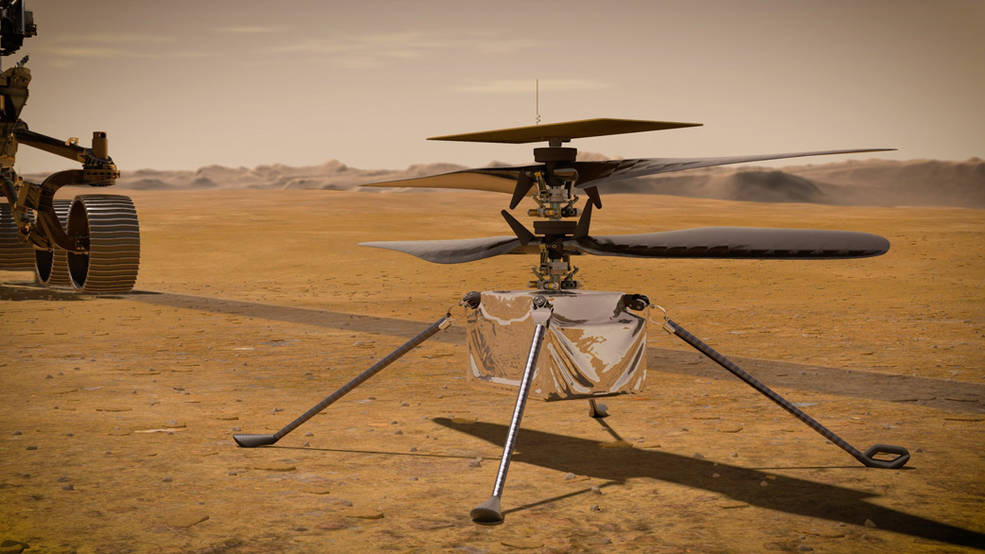
You can follow the Mars 2020 mission flight path here:
https://eyes.nasa.gov/apps/orrery/#/sc_perseverance
The solar powered Ingenuity helicopter is a technology demonstration experiment aimed at attempting the first flight on Mars.
It is stowed on the belly and receives its charge from the rover’s power supply.
The four legged Ingenuity has a mass of about 4.0 pounds (1.8 kilograms) and stands 1.6 feet or 19 inches (0.49 meters) high. It is equipped with two counter rotating blades for lift spinning at about 2,400 rpm and two cameras.
After Ingenuity is deployed on Mars’ surface its batteries will be charged solely by the helicopter’s own solar panel. If Ingenuity survives the cold Martian nights during its preflight checkout, the team will proceed with testing.
Under clear blue sunshine drenched skies the car-sized Perseverance Mars 2020 rover lifted off right on time at 7:50 a.m. EDT (1150 GMT) 30 July 2020 aboard a 19 story tall ULA Atlas V 541 rocket from Space Launch Complex 41 on Cape Canaveral Air Force Station, Florida.
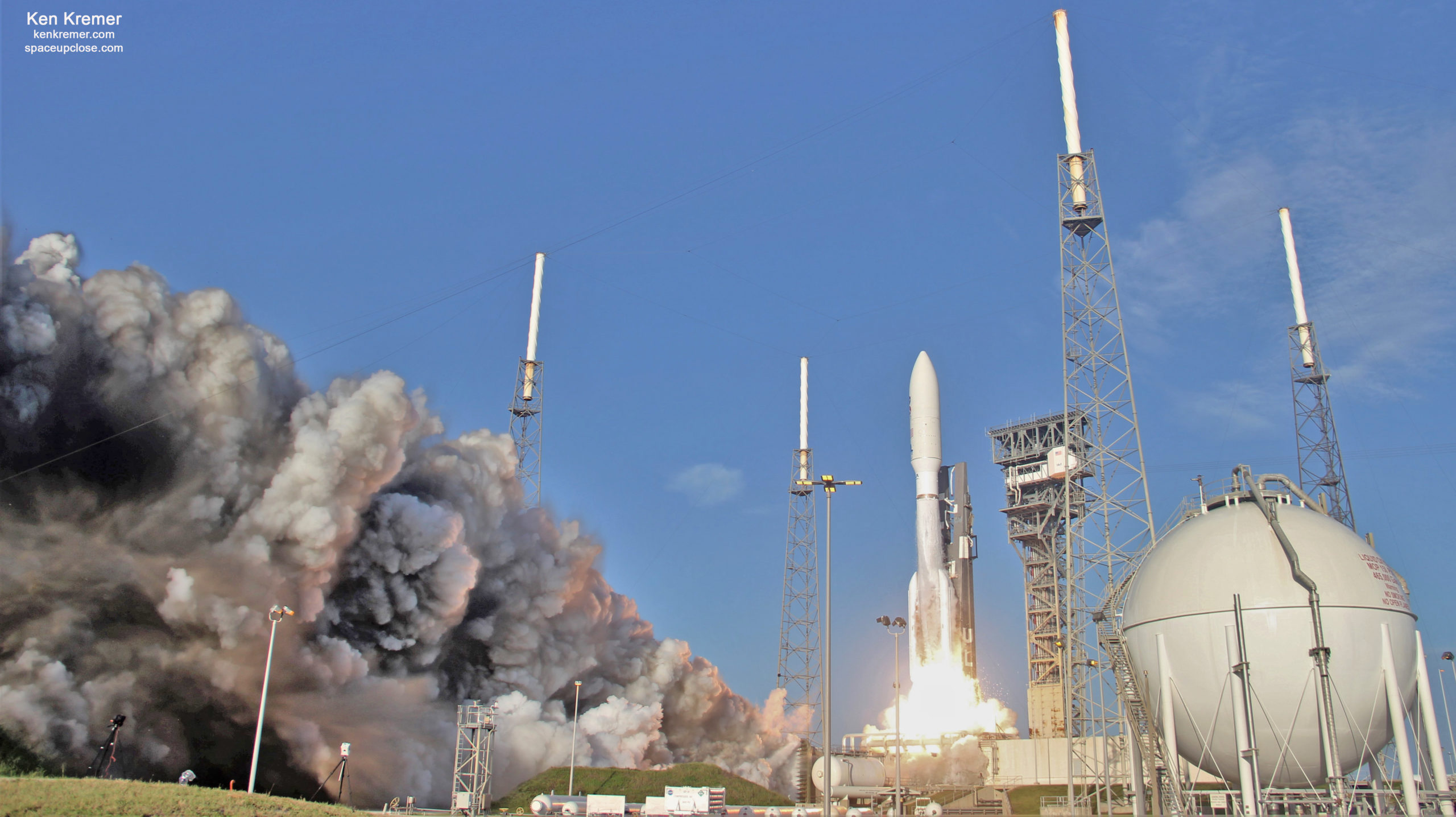
Check out our launch story and launch and prelaunch photos from pad 41
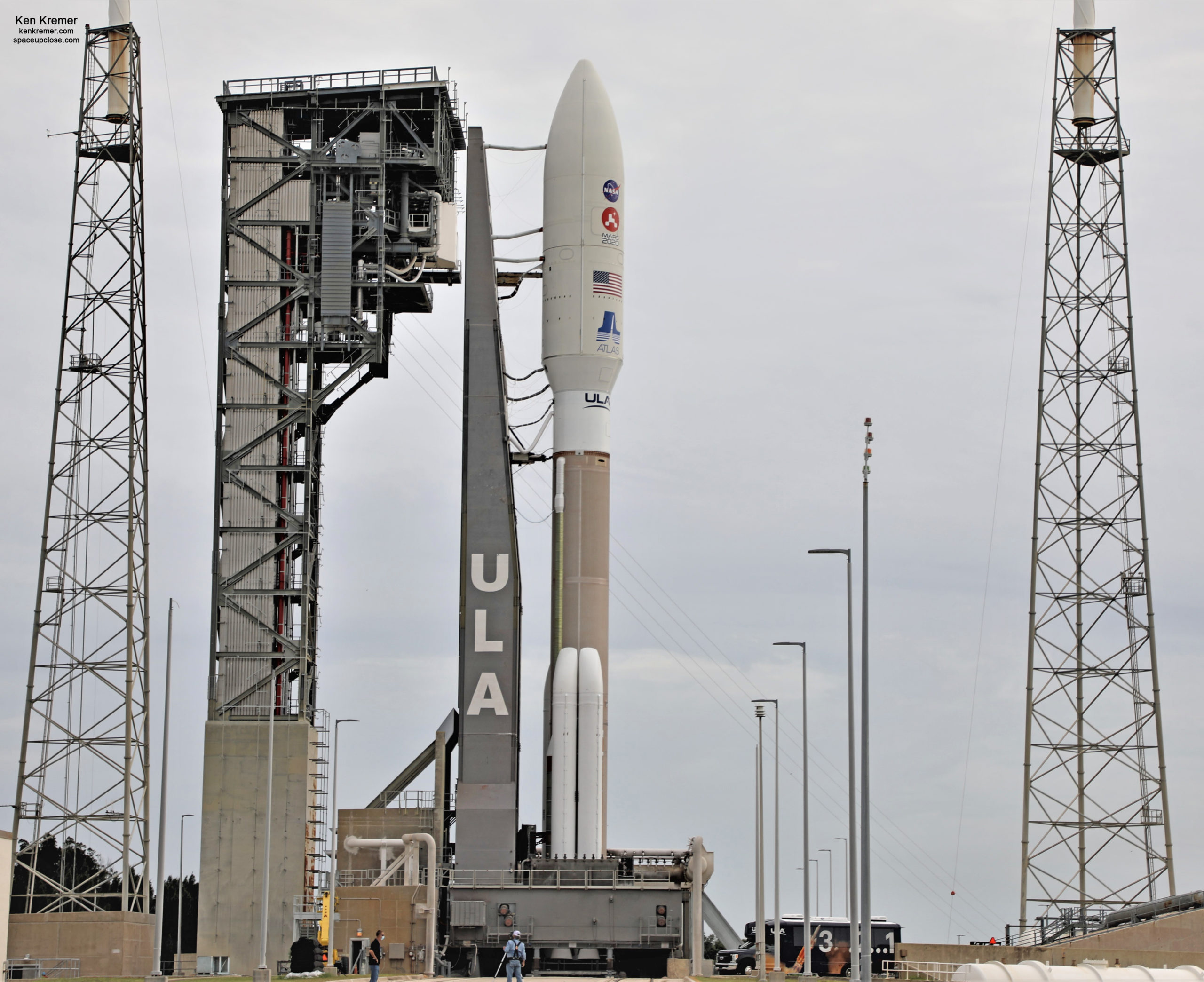
Learn more about Mars 2020 here:
Download our Free “Mars 2020 Exploration Mission Guide” created by RocketSTEM magazine and Space UpClose:
https://www.rocketstem.org/2020/07/20/mars-2020-mission-overview/
Link on Space UpClose Home Page upper right below Social Media links
My 12-page ‘Mars 2020 Perseverance Rover Mission Overview’:
https://www.rocketstem.org/2020/07/20/mars-2020-mission-overview/
Meanwhile her older twin sister river Curiosity just celebrated 3000 Sols of exploring Mars.
See my Sol 3000 mosaic and story here:
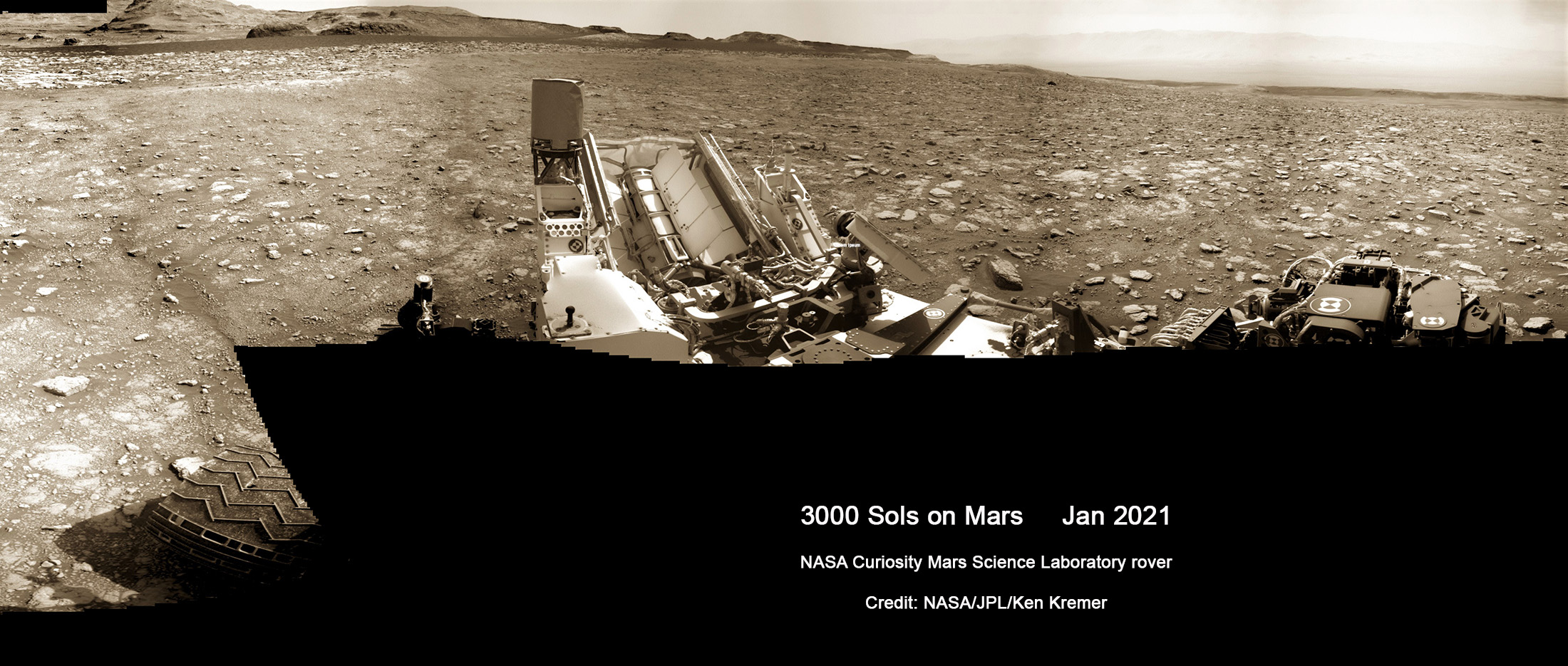
Watch our live and complete ‘Stay Curious’ with live Perseverance landing commentary today Feb 18, 2021 as well as earlier programs on Mars Mania on Feb 12 and Dec 14 and Dec. 30 , 2020 shows on many space topics including Mars Perseverance, Artemis and human spaceflight.
https://www.facebook.com/175507880819/videos/752176242375043
https://www.facebook.com/175507880819/videos/3246699658764085
https://www.facebook.com/175507880819/videos/226784775573274
https://www.facebook.com/175507880819/videos/775199953071117
Watch Ken’s continuing reports about Mars 2020 Perseverance and Curiosity rovers, Artemis and NASA missions, SpaceX, Starlink, Commercial Crew and Starliner and Crew Dragon and onsite for live reporting of upcoming and recent SpaceX and ULA launches including Crew 1 & 2, Demo-2, ISS, X-37B, Solar Orbiter, NRO spysats and national security missions and more at the Kennedy Space Center and Cape Canaveral Space Force Station.
Stay tuned here for Ken’s continuing Earth and Planetary science and human spaceflight news: www.kenkremer.com –www.spaceupclose.com – twitter @ken_kremer – email: ken at kenkremer.com
Dr. Kremer is a research scientist and journalist based in the KSC area, active in outreach and interviewed regularly on TV and radio about space topics.
………….
Ken’s photos are for sale and he is available for lectures and outreach events
Ken has created hundreds of widely published Mars rover mosaics and lectures also about NASA’s Mars rovers
Please consider supporting Ken’s work by donating at Patreon:
https://www.patreon.com/kenkremer
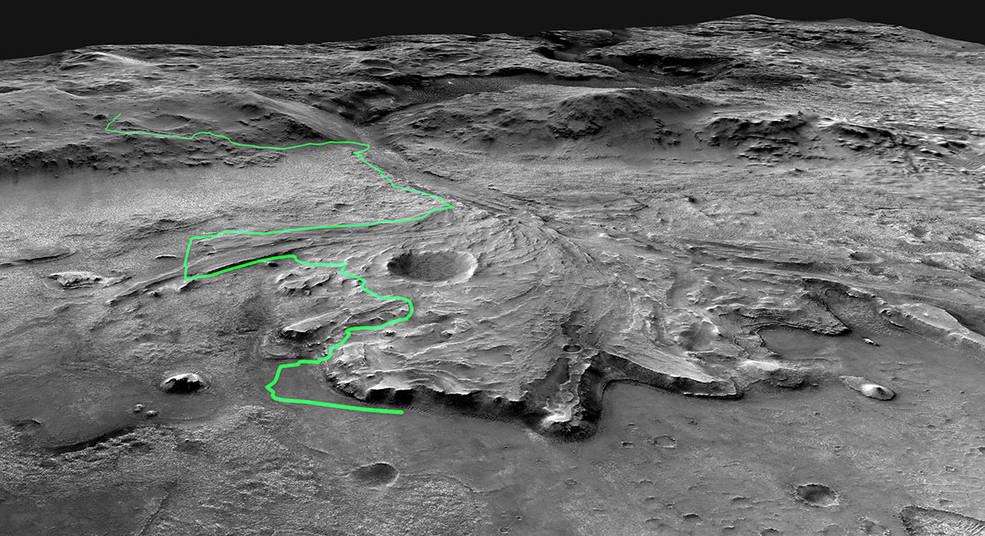
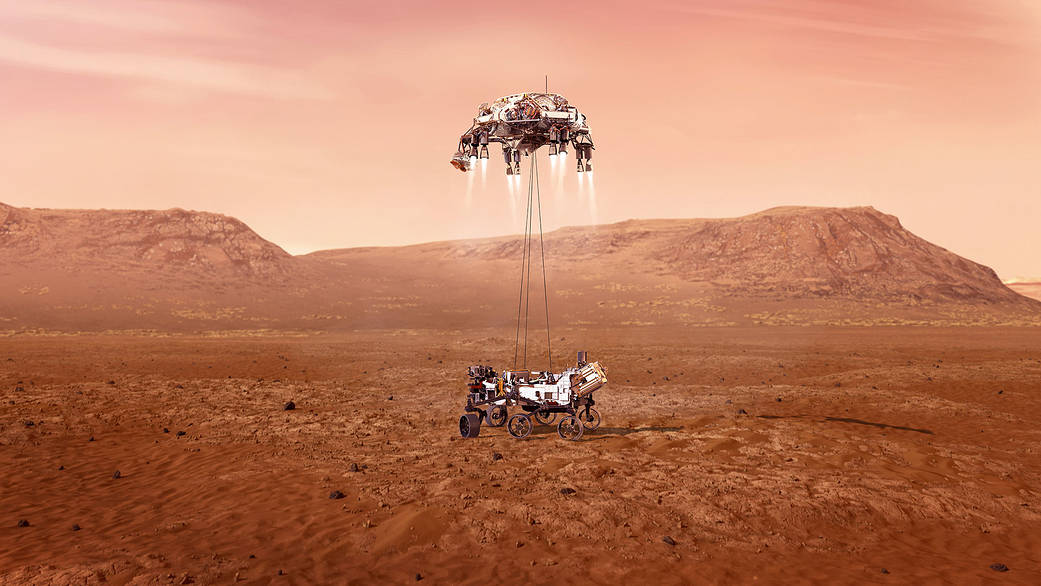
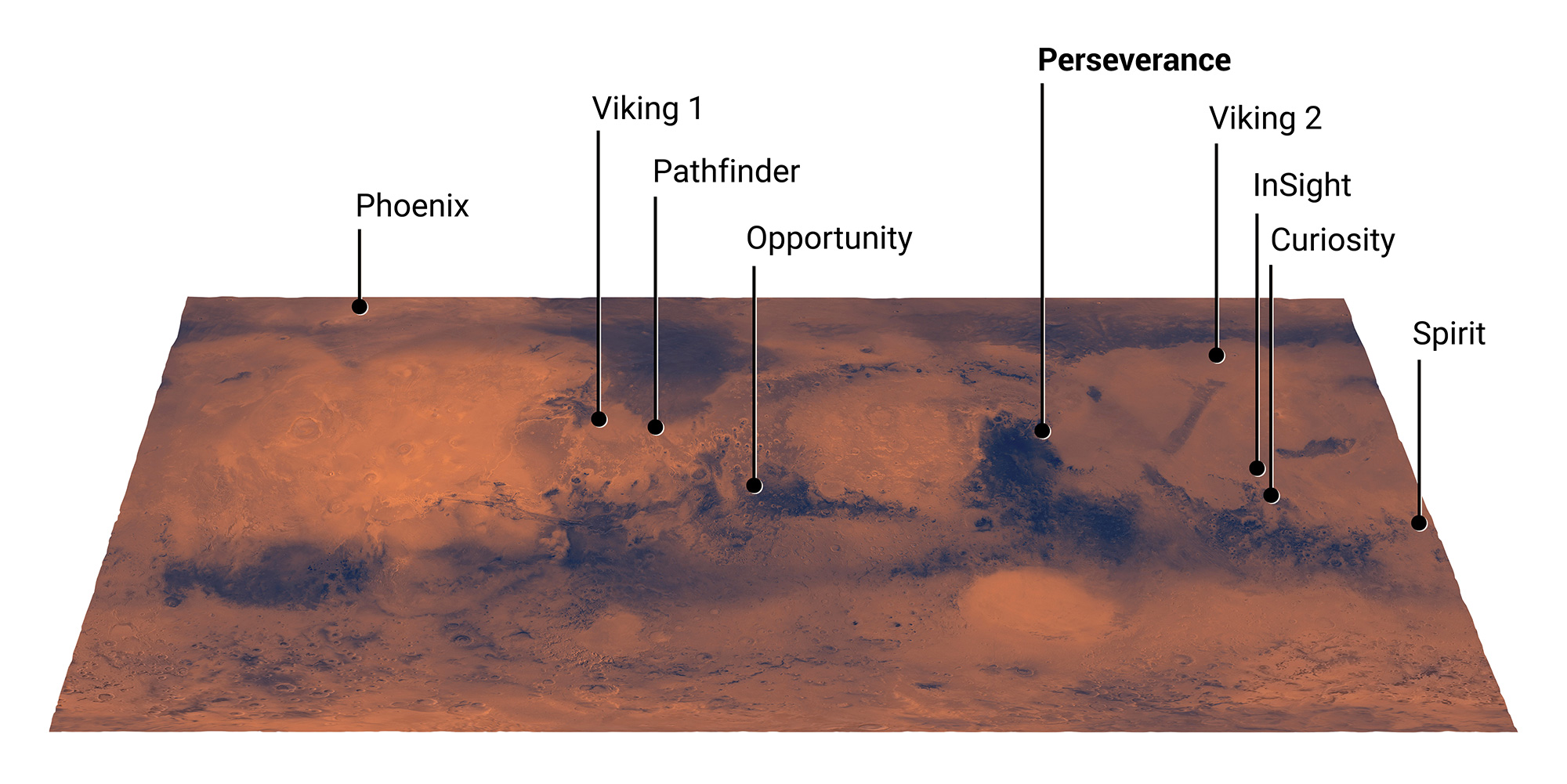
x



